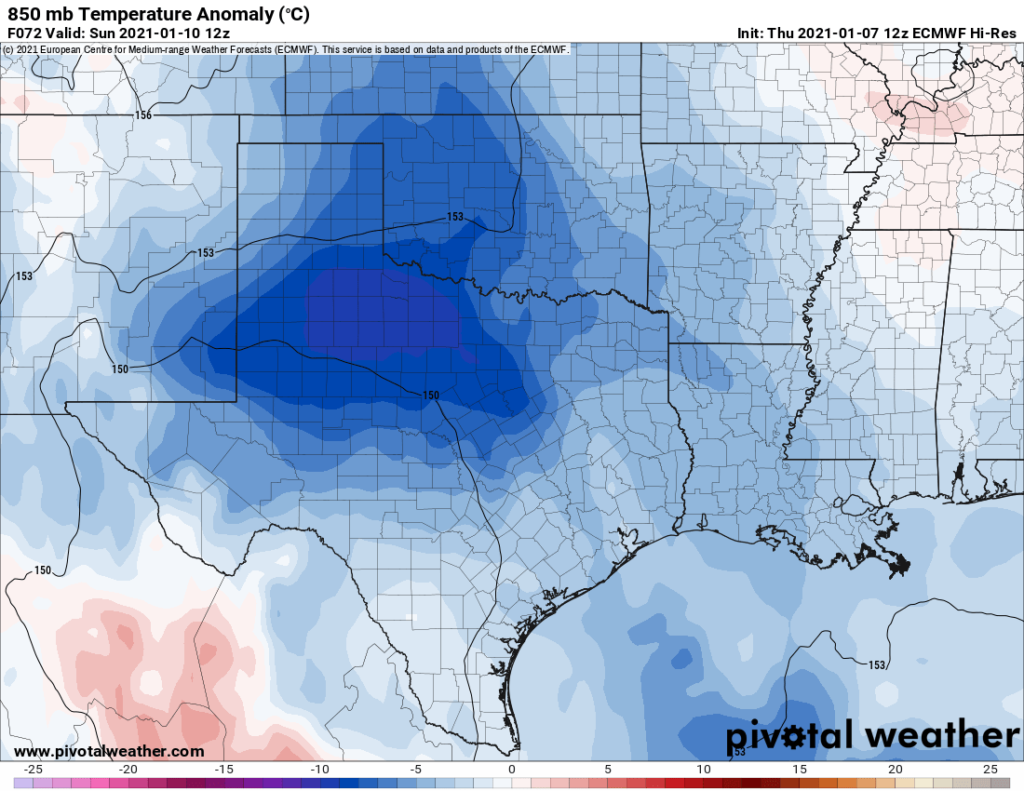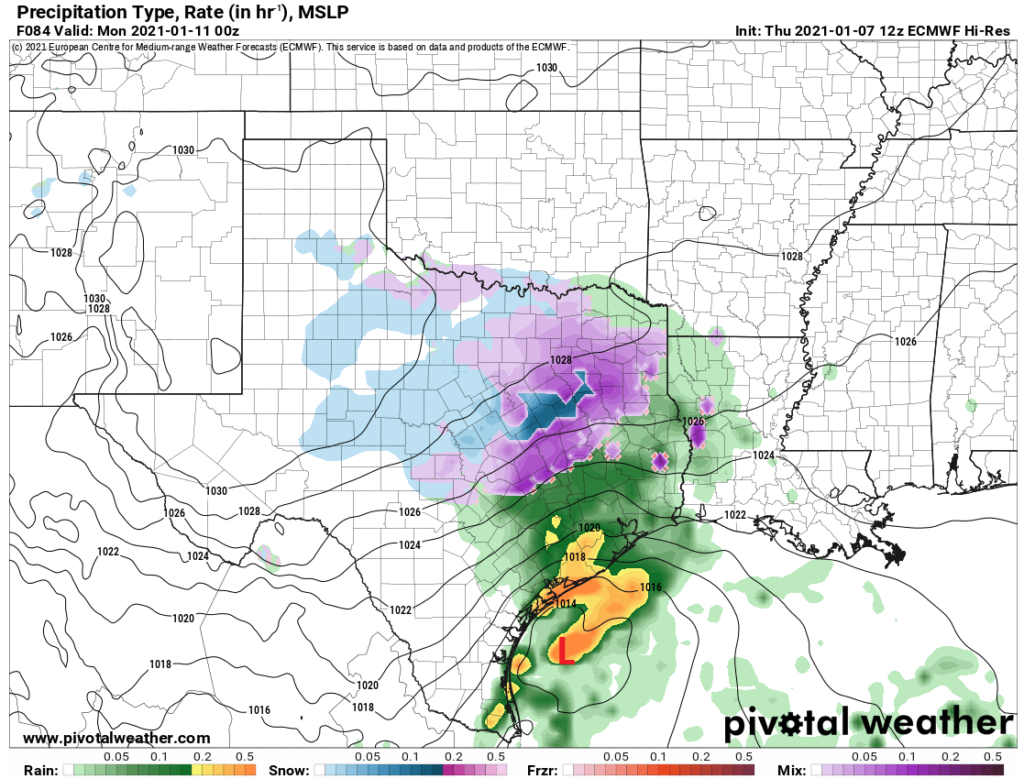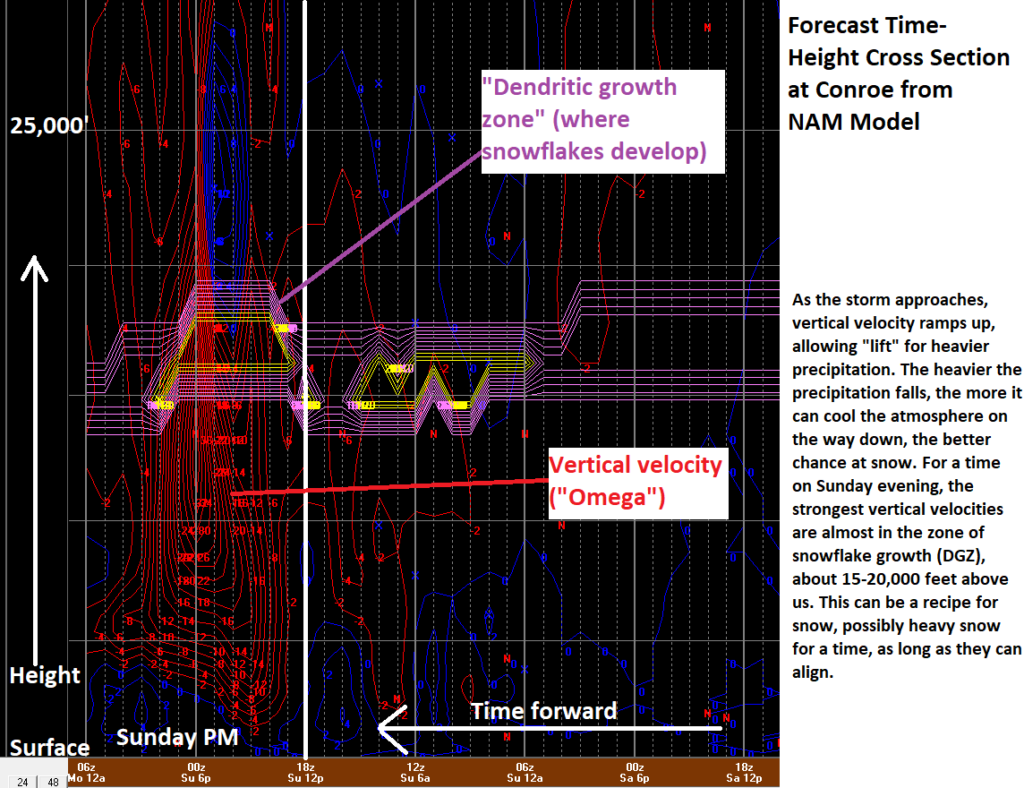As a Jersey transplant, having a bonafide winter storm to forecast feels like a Super Bowl or something to me. So in this post, we’re going to go under the hood a bit on the ways it may or may not snow in the Houston area.
How it happens
First, let’s just tackle the big picture story. Why are we even talking about this? More often than not this time of year, we see storm systems pass by to our north and drag cold fronts through. And we get some rain or storms, and then it turns windy and cold but much drier behind the front. On Sunday and Monday, things happen a bit differently. First off, on Sunday morning, the air mass over Texas is quite chilly. This is a map of temperature anomalies 5,000 feet above our heads as forecast by the European model on Sunday morning.

The air mass isn’t super cold, but it’s a few degrees colder than normal, colder still in West Texas with an upper level storm system passing by at 20,000 feet above their heads. While this certainly keeps things appetizing, the best word to describe the air mass over Texas is marginally cold. I’d like to see it colder to be more excited about snow chances. Alas, we’ll work with this.
What do we need next? Ideally, a coastal low pressure system at the surface. And we get just that on Sunday evening. By 6 PM or so, the European model shows the surface low just off Corpus Christi.

Keeping it to our south is critical because that will limit or inhibit warm air from being drawn into our area. So at this point in the game, widespread cold rain should be breaking out across the region. Temperatures will begin to fall toward the dew point as rain cools the air, and we may have temperatures down into the upper-30s to near 40 in Houston and south by evening, with mid to upper-30s north. It’s plausible that some sleet or snow could mix in with the rain at times, mainly along or north of Highway 105; think Lake Livingston, Conroe, Cleveland, Navasota.
Ultimately, how far north or south both the surface low and upper low (which is expected to be just east of the Caprock on Sunday evening) matter. If they shift farther south, colder air is possible and that rain/snow mix may start off farther south. The opposite is true if they’re farther north. Here’s an example. You see the European model above. The GFS model is very similar looking. The NAM model earlier this morning showed the surface low about 50 to 75 miles farther east at this same time, and it has the upper low south of Abilene, or about 175 miles farther south of where the Euro has it at this time. As a result, it would explicitly be showing snow as far south as Montgomery County at this point and pockets of a rain/snow mix closer to Houston. The most recent NAM model just came out, and it has the surface low about 25-50 miles farther north, which makes Houston warmer and keeps snow bottled up north of Highway 105. Which model is right? We have no idea right now. But this will be critical in determining how far south snow can get early on. We will watch this tonight and tomorrow into Saturday closely.
The other way to get snow
As we go into Sunday night, the storm will progress off to the east and northeast. For Houston and points south, again, mainly a cold rain with temps steady in the 30s or low-40s. North of Houston, it should be rain, periodically mixed with snow. Here’s the interesting thing about the chance of snow north of Houston, up along highway 105 or so though with this storm. I think it’s actually really legitimate. One of the hallmarks of this system showing up on the models this week is how “dynamic” it seems. There are several ways to get snow. Above, we talk about getting enough cold air via a favorable storm track. Now, let’s talk about dynamics. When you get enough vertical motion within a storm system, basically a lot of rising air, you tend to drop temperatures. We call this “dynamic cooling.” In winter storms like this, another way to get snow is for it to essentially rain so hard that the air cools enough for the rain to flip over to snow. I think we are close to having a case be made with this storm that we could see enough dynamic cooling occur that, in spots, heavy rain could suddenly flip to heavy snow at the height of the storm Sunday evening. Thundersnow can’t be ruled out either.
Let’s get even more technical. If we look at the latest NAM model from this afternoon, we can see how this might occur. The image below is what we call a time-height cross-section. It’s basically taking a specific location, in this case Conroe, and looking at how vertical velocity (VV, or rising air) and the dendritic growth zone (DGZ, or where air temperatures cool to roughly -10 to -20°C, good for snowflake production) change over time.

You can click the image to enlarge it. In that image above, one thing stands out to me. We have a lot of vertical velocity with this storm, and the strongest VVs come close to punching the heart of the dendritic growth zone at times. In English? That creates a very sloppy setup where, yes, we may see rain most of the time, but if it rains hard enough, there will be pockets anywhere (mainly north of I-10 though) that could change from rain to accumulating snow or sleet and back to rain at times.
This means that it will be difficult to near-impossible to give you a snowfall forecast right now, as those sorts of processes are very small scale. I come from the Northeast, and they’re difficult to forecast this far out up there; they’re next to impossible to forecast this far out in the South.
As the storm pulls away early on Monday morning, enough colder air may drift in to have the rain end as some light snow or flurries/drizzle across parts of the area, again mainly north of I-10. No accumulation would be expected from that. Monday will likely be a gray, cold day.
So let’s summarize what we’ve got quickly.
- Snow, and accumulating snow at that is becoming more likely across the northern stretches of Southeast Texas, particularly along and north of Highway 105.
- Accumulating snow can’t be ruled out anywhere north of I-10 just yet, but it’s more likely that some places maybe flip back and forth from rain to snow/sleet to rain with little to no accumulation.
- Ice is not likely with this storm, though well north of Houston, some roads could be slick at times (think Huntsville or Lake Livingston areas).
- There is still sizable uncertainty on specifics regarding the details of this storm and significant forecast changes may occur between now and Sunday.
- Locally heavy rain is possible south of Houston, along with some thunder.
- It will likely be a bit windy as well, and there is the potential for some coastal flooding along the Gulf, with rough seas and strong rip currents.
More for you tomorrow morning!

Well, if we’re going to get THAT technical, explain why the graphic reads right to left in time instead of left to right.
HA…your guess is as good as mine. I’ve never really found it too tough to get past, but I’ve also never found it especially logical.
Snow all the way to the coast!!!!
Only problem is, with so many people working from home, the morning newscasters won’t have nearly as much fun telling everyone to stay home due to lethal snow flurries in the area….
I’m up in Austin, how do the chances for accumulating snow look there? Loce
Love your posts! (Is what i meant to type instead of loce)
You may just be a little too far south to get in on it (I’d be happier if I were in Waco for this one). But it’s still a close call.
Mmm cold rain my favorite. 🙄
Baby, it’s gonna be cold outside.
Do you think Huntsville would be far enough north to catch any snow for a very eager 3 year old?
Noooooo!
Fellow Jersey transplant! I don’t get so excited about snow anymore, but I can understand how you feel, Matt. I am very happy living in Houston. My husband likes to say “you don’t have to shovel humidity.”
Thanks for the insight and details, Matt! Love that you’re getting a chance to geek out over snow!